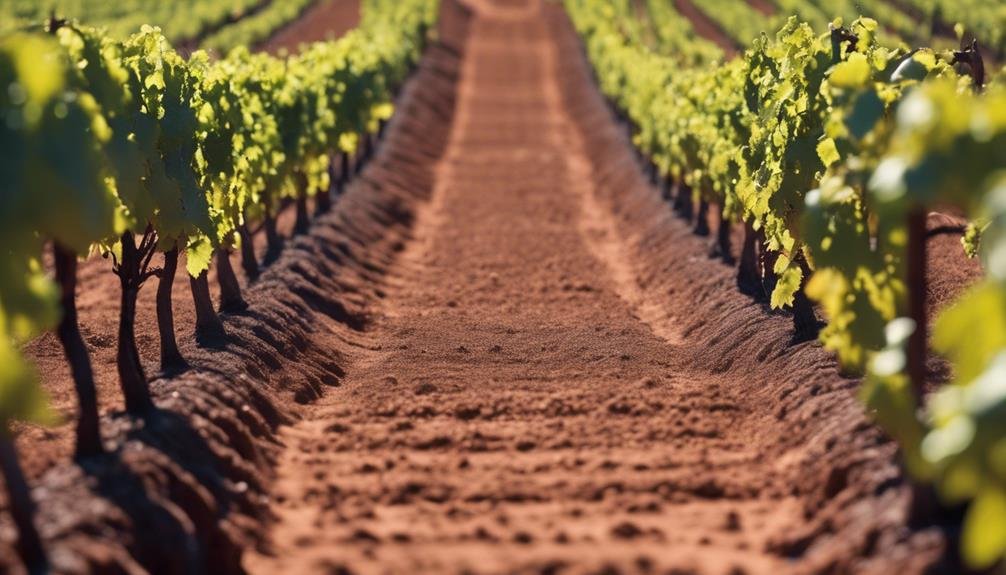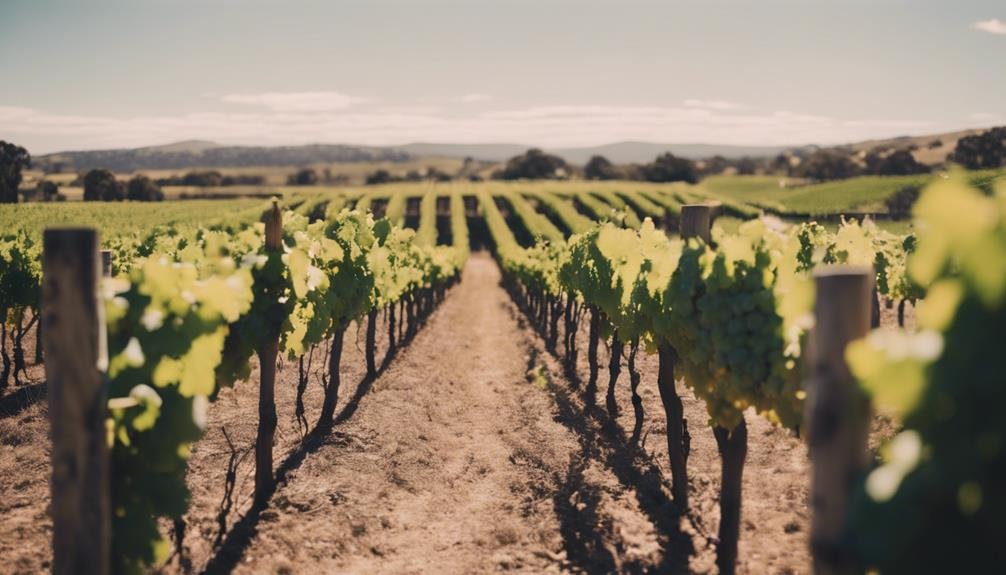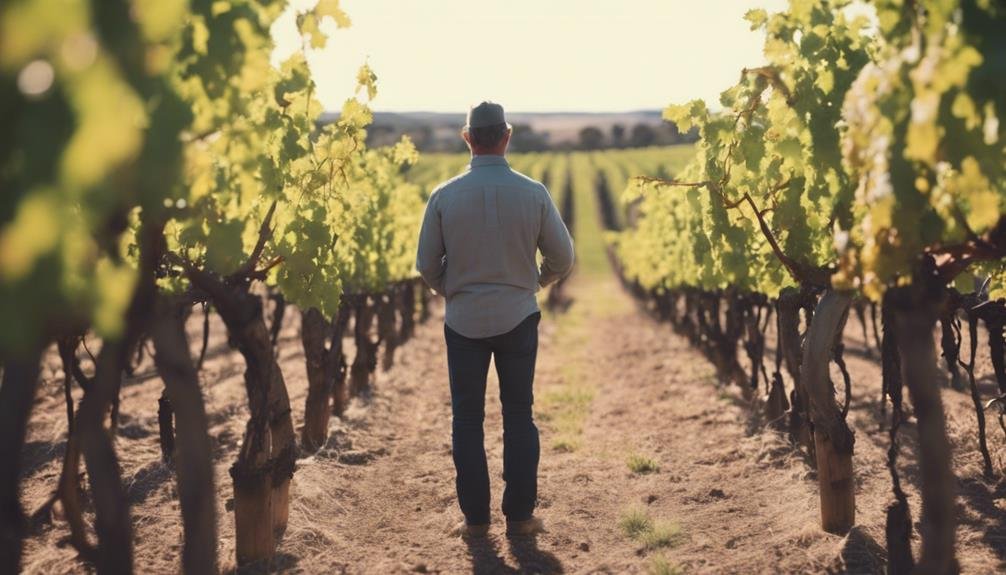Explore South Australia's wine wonderland, known for diverse regions like Barossa Valley's powerful Shiraz, Eden Valley's cool climate wines, and Adelaide Hills' oak-aged Chardonnay. Each region offers unique terroirs influencing flavor profiles. From the vibrant acidity of Clare Valley's Riesling to Coonawarra's black fruit notes in Cabernet Sauvignon, the wines showcase distinctive characteristics shaped by soil diversity. Discover how operational intricacies, economic facets, and a balance between tradition and innovation drive the industry forward. Witness emerging trends like sustainable practices and a demand for organic wines. Unravel the fascinating world of South Australia's wine wonderland for a truly enchanting experience.
South Australias Wine Regions
South Australia is renowned for its diverse wine regions, each offering distinct terroirs and producing a wide range of exceptional wines. Climate influences play an essential role in shaping the character of these regions.
Vineyard practices vary across the state, with each area employing specific techniques to maximize grape quality. From the Barossa Valley known for its powerful Shiraz to the cooler climate of Eden Valley producing elegant wines with intense acidity, South Australia boasts a rich tapestry of wine-growing areas.
The Adelaide Hills excels in oak-aged Chardonnay and Sauvignon Blanc, while Clare Valley is celebrated for its dry Riesling and Cabernet Sauvignon. Each region's unique climate and vineyard practices contribute to the diverse array of wines that South Australia has to offer.
Unique Wine Characteristics in SA
Showcasing distinctive flavors and sensory profiles, South Australia's wines exhibit a diverse array of unique characteristics that set them apart in the world of winemaking.
The region's climate impact, with varying temperatures and soil compositions, influences the grape varieties grown, leading to exceptional flavor profiles and aging potential in the wines produced.
Grape varieties like Shiraz from Barossa Valley are known for their powerful and flavorful expressions, while Riesling from Clare Valley offers vibrant acidity and longevity.
The Cabernet Sauvignon from Coonawarra in the Limestone Coast region showcases black fruit-driven notes with a tobacco-laced finish, thanks to the region's iron-rich clay soils.
These distinct characteristics make South Australia a wine lover's paradise, offering a wide range of exceptional and unique wine experiences.
Importance of Soil and Terroir

Emphasizing the pivotal role played in shaping the distinctive characteristics of South Australian wines, the soil and terroir of the region stand as fundamental pillars of quality winemaking.
- Soil Diversity: South Australia boasts a rich tapestry of soil types, from the iconic red terra rossa soils of Coonawarra to the iron-rich clay soils of the Limestone Coast.
- Terroir Influence: The unique combination of soil composition, topography, and microclimate in each sub-region influences the flavor profile and quality of the wines produced.
- Terra Rossa Region: Known for its red-colored soils, this area is famous for producing Cabernet-based wines with distinctive black and red fruit flavors, tobacco, and minty notes.
- Affordability and Mechanization: The majority of wines from soil-diverse regions like Coonawarra are affordable due to efficient mechanization, making quality wines accessible to a broader audience.
Production Insights and Commercial Aspects
With a focus on the operational intricacies and economic facets of the wine industry, this section explores the production insights and commercial aspects of South Australia's winemaking landscape. South Australia's market dynamics and export strategy play crucial roles in the industry's success.
The region's diverse grape varietals and blending techniques contribute to the quality and uniqueness of its wines. Understanding the balance between tradition and innovation is essential for winemakers to thrive in this competitive market.
Emerging Trends in SA Wine Industry

In the dynamic landscape of South Australia's wine industry, innovative practices and evolving consumer preferences are shaping new directions for winemakers.
- Sustainability Practices: Winemakers are increasingly adopting sustainable viticulture and winemaking techniques to minimize environmental impact and preserve resources for future generations.
- Indigenous Winemakers: There is a growing recognition of Indigenous winemakers in South Australia, who bring unique perspectives and traditional knowledge to the industry.
- Organic and Biodynamic Wines: The demand for organic and biodynamic wines is on the rise, with more wineries embracing these practices to cater to environmentally conscious consumers.
- Minimal Intervention Wines: Winemakers are exploring minimal intervention winemaking, allowing the natural characteristics of the grapes and terroir to shine through in the final product.
Wine Education Resources in SA
One valuable resource for wine enthusiasts seeking to enhance their knowledge and appreciation of South Australia's wine industry is the array of educational programs and materials available.
Tasting workshops offer an interactive experience to explore different varietals, understand tasting notes, and learn about food pairings.
Vineyard tours provide a firsthand look at the winemaking process, from grape to bottle, allowing participants to see the terroir and techniques that make South Australian wines unique.
These educational resources not only deepen understanding but also create memorable experiences that connect enthusiasts with the rich history and craftsmanship of the region's winemaking.
Whether you are a novice or a seasoned connoisseur, these opportunities can enrich your appreciation for South Australia's diverse and vibrant wine culture.
Notable Figures in SA Wine Industry

Exploring the influential figures shaping South Australia's wine industry sheds light on the dynamic personalities driving innovation and excellence within the region's viniculture landscape.
- Madeline Puckette co-founded Wine Folly to educate people about wine, offering insights that demystify the world of wine.
- Industry influencers like Madeline Puckette have played a significant role in promoting wine education initiatives and enhancing wine appreciation.
- Wine Folly's initiatives, including newsletters and online resources, have helped individuals understand and appreciate wine in a more accessible way.
- Madeline Puckette, a James Beard Award-winning author and Wine Communicator of the Year, continues to be a prominent figure in the wine industry, contributing to a more informed and engaged wine community.
Frequently Asked Questions
How Does the Maritime Influence Impact Wine Production in South Australia?
Maritime microclimates in South Australia influence wine production by moderating temperatures, extending grape maturation periods, and imparting unique characteristics to wines. Soil composition and terroir influences further enhance grape quality, contributing to the region's diverse wine offerings.
What Are the Sustainability Practices Adopted by Wineries in South Australia?
Wineries in South Australia implement sustainable practices such as organic farming and water conservation. By embracing these methods, they aim to reduce environmental impact, preserve resources, and produce high-quality wines that reflect a commitment to sustainability.
Are There Any Indigenous Grape Varieties Unique to South Australia?
Indigenous grape varieties unique to South Australia include the rare and distinctive Assyrtiko, Montepulciano, and Nero d'Avola. These grapes offer unique flavors to the region, showcasing South Australia's diverse and vibrant wine landscape.
How Do Wildfires and Climate Change Affect Vineyards in the Region?
Wildfires and climate change pose significant challenges for vineyards in South Australia. To address this, vineyards implement wildfire mitigation strategies and adopt climate adaptation techniques. These efforts are essential to safeguarding the region's wine industry and vineyard sustainability.
What Are the Key Export Markets for South Australian Wines and Their Preferences?
South Australian wines find favor in diverse export markets worldwide. Preferences vary, with some markets leaning towards bold Shiraz or elegant Riesling. Export trends highlight the region's ability to cater to a spectrum of consumer tastes and demands.
Conclusion
In the dynamic world of South Australian wines, tradition and innovation coalesce to create a tapestry of flavors that captivate the senses. From the storied vineyards of Barossa Valley to the emerging trends in the industry, South Australia's wine wonderland offers a journey of discovery and delight.
Through a harmonious blend of heritage and modernity, each sip tells a tale of passion and craftsmanship, inviting wine enthusiasts to explore the diverse and ever-evolving landscape of oenology in this region.